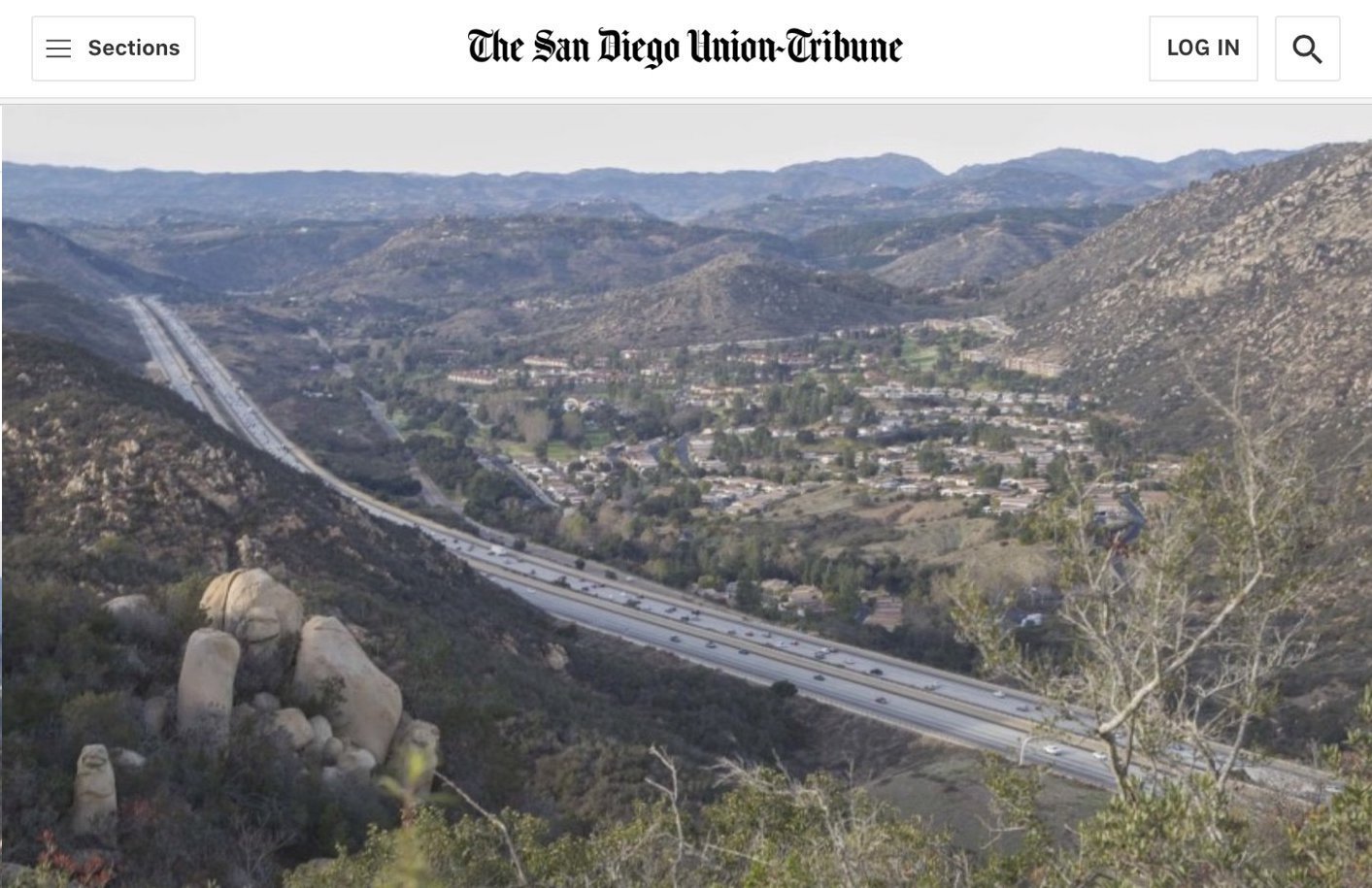Borrego Springs (District 5), Photo courtesy of Allie Caulfield
This is part 3 of an ongoing series about the 2020 County Board of Supervisors race focusing on their land use and housing stances exclusively. Click here to start at the beginning.
Prior to 2019, the Board was dominated by supervisors who, despite approving a forward-thinking General Plan, were widely seen as being developer-friendly and likely to approve GPA projects. GPA projects seeking permission to upzone remote, vacant land had a friendly board and the investment calculus was in the speculator’s favor. Cheap land (lacking development potential) could be converted into a gold mine via a simple 3 to 2 vote. Dianne Jacob was the only Supervisor (along with supervisor Pam Slater-Price before she stepped down) who pushed back against GPA projects, and was generally against sprawl-oriented projects. Unfortunately, she was always outweighed 4-1 by Supervisors Cox, Roberts, Horn and Gaspar. This perverse incentive (and lack of vision on the Board) led to a long pipeline of GPAs being proposed by developer/investors seeking to cash in on the permissive board.
With two new faces on the Board, it is not entirely certain which way the Board will go when faced with large sprawl GPA projects, at least for the next two years. We will soon find out as there will likely be upwards of at least 3 or 4 coming to the board this year.
The 2018-2020 Board
The current board seems to be doing things quite differently to the previous one when it comes to issues like homelessness and immigrant refugees. From a land use perspective we have some data points to draw from:
- County’s decision to appeal the Sierra Club ruling: The Board ruled 3 to 2 to appeal a ruling that would basically send the County back to the drawing board on its fatally flawed (and lacking) Climate Action Plan. More details on that ruling and its implications here, but basically it invalidated GPAs in the pipeline that relied on “out of county” carbon offsets the judge ruled inadequate. Who voted against the appeal? Diane Jacob and Nathan Fletcher. An appeal basically means that the County rejects the judge’s ruling and is going to spend inordinate amounts of money fighting it, delaying project votes and introducing uncertainty into the planning process. Desmond, Jacob and Cox apparently felt that the County did not put forth a flawed Climate Action plan. So, that is an early indicator of how the current Board might vote on GPA projects–not entirely promising.
- Community Choice Energy: Jacob and Fletcher put Community Choice Energy on the agenda last month, concurrent with similar decisions in the City of San Diego, Encinitas and Solana Beach. It basically gives residents in the County a choice as to the source of their energy (something that the County administration already does for its own energy needs), an effort to increase renewable energy sources. On 2/28, the Board voted unanimously to move forward with a CCE initiative and instructed staff to study the issue and come back in October with feasibility studies and a business plan for CCE. While not specifically a land use policy, the direction the board ultimately takes on CCE is an indicator of how much importance they place on sustainability which is directly related to land use decisions. What happens in October will be more indicative of how serious the entire board is about meeting climate change objectives.
- Affordable housing investments: Diane Jacob, in her latest “state of the County” speech, proposed doubling the County’s housing trust fund to increase the amount of affordable housing in the County by 1,000 units. They’ll vote on that in a few months. More money for affordable housing is much needed, especially since that is truly where the crisis is, not in market rate housing. This will show us if the board truly walks the walk on affordable housing.
- Accessory Dwelling Unit: The board proposed and approved waiving permitting and development fees for ADUs anywhere in the County, saving homeowners upwards of $15,000 on the cost of building backyard granny flats or casitas. They are also looking at adopting Encinitas’ plan to offer free permit-ready, pre-engineered plans for people seeking to build ADUs in their backyard (which is saving Encinitas residents an additional $20,000). We support the addition of ADUs as a tool to encourage affordable housing, though it would add additional density beyond what is allowed (and mitigated for) in the General Plan. Ideally, ADU capacity could be deducted from existing General Plan capacity to keep the GP consistent with its principles.
- Fire Safety: Jacob’s state of the County also addressed a new push for more fire safety in the County which would be brought forth later this year by Jacob and Desmond (who both preside over the most fire prone stretch of the County). Hopefully they will look at taking a more rigorous look at how developments might affect evacuation flow with accurate modeling. Grow the San Diego Way submitted policy recommendations (letter here) on increasing the scrutiny on any development in very high fire severity areas, specifically looking at more rigorous evacuation analysis when GPA developments are proposed.
So it looks like the current board is heading in the right direction with Jacob and Fletcher leading the way in sound land use and planning policy. But there may not be enough votes to push back against the sprawl GPA projects that are most harmful to public safety, quality of life, habitat and environment. Here’s what we know on the current board:
Cox, District 1: Cox is termed out though it is likely he will be voting on at least one of these big projects in the next 20 months. In the past, he has been a fairly reliable vote in favor of large sprawl projects or up zones (Newland Sierra, Harmony Grove Village South, Valiano, PSRs and Otay 250). It is possible that, in the past, Cox deferred to former Supervisor Horn, whose district contained most of the GPAs. It is not clear whether or not he will change his stance before the end of 2020, though there is a possibility that his new relationship with Jacob and Fletcher might see him agreeing with them on GPA projects and development in the unincorporated area.
Jacob, District 2: As a termed out supervisor, Dianne Jacob will have 20 months to cement her legacy at the Board of Supervisors and she seems to be doing just that. She has been supportive of preserving open space, wildfire protection and reliably voted against sprawl-oriented projects. She was elected Chair of the Board last month and gave a state of the County address which emphasized health, housing affordability and fire safety. In a recent Q&A with the San Diego Union Tribune, she faced tough questions and was quite firm on the importance of keeping the backcountry from being developed while encouraging the general plan density in the western part of the County.
“Our general plan update that was done in 2011, cost us a lot of money, a lot of time, but the fact of the matter is what that did, it put growth in the right place. It transferred density basically from the back country, the high fire prone areas, into the more urban, suburban areas. We have three times as much density in that plan than the required number or required allocation by SANDAG. San Diego Union Tribune, 2/21/2019, Q&A with Board of Supervisors Chairwoman Dianne Jacob
Gaspar, District 3: Kristen Gaspar has a reputation for being very pro-development and in fact received a lot of support from the building industry in her election, with close to a million dollars in PAC money spent to get her elected (both supporting her and opposing her opponent). Though she did oppose development as mayor of Encinitas, she was endorsed by the Building Industry Association and it appears that she has voted in favor of every project and upzone that has come her way since she took office at the Board of Supervisors. Gaspar has not declared her intent to run again and will be facing at least two challengers.
Fletcher, District 4: Grow the San Diego Way met with Nathan Fletcher and his staff recently to discuss his perspective on land use. He is on record supporting smart growth, urban density and better transit and he is in a position to do something about it. One of his three priorities is the environment. In a recent interview with the Union Tribune he details the importance of reining in greenhouse gases (GHGs) and the outsize role that driving plays (as a result of poor land use practices). And on the campaign trail he told the UT Editorial Board that he did not think GPAs were the right approach:
“I don’t think that the new ones here in Lilac Hills are the approach that I would take or where I would want to go and I think for all the reasons you just outlined and I also don’t know that we take one project and say, well this is going to solve the problem when the scope is so magnitude.” San Diego Union-Tribune, April 6, 2018, San Diego County Board of Supervisors candidate Nathan Fletcher: The Union-Tribune interview
He was recently appointed by Governor Newsom to the California Air Resources Board (CARB) which is tasked with protecting the public from air pollution and reducing GHG emissions which necessarily involves limiting sprawl, one of the main drivers of GHGs. As mentioned earlier, he voted against appealing the Sierra Club verdict (though a majority chose to move forward with the appeal).
Desmond, District 5: Jim Desmond has a reputation for being fair, but also was accused of being very developer friendly as mayor of San Marcos. He was endorsed by the BIA in 2018 for Supervisor. He faced a revolt from local citizens for his approval of a highly unpopular project, San Marcos Highlands, that was seen as destructive to wildlife corridors and habitat, and faced a recall of a decision to approve a Brookstone Homes GPA without increasing the infrastructure (schools and roads) to accommodate the added density.
He was also originally in favor of Lilac Hills (and appeared on a flyer for Measure B, a developer-funded initiative to approve the controversial project in 2016). However, during the 2018 campaign season, he seemed to retract his support for the project on account of infrastructure deficits he claimed he had been unaware of. And when directly questioned during a town hall debate in Valley Center, he came out against the controversial bundling of GPAs. In addition, he was one of the only SANDAG board members to push for accepting a lower housing number from the state which was later controversially reversed by the board by invoking weighted voting (which gives more power to the big cities). So a mixed bag when it comes to smart growth and planning; it is unclear where he will stand on the upcoming GPA projects in the pipeline (Lilac Hills, Warner Ranch and Otay 14).
In Summary: So, although Fletcher and Jacob are likely to vote in favor of smart growth and against unsustainable, sprawl-inducing projects, with 4 or 5 in the current pipeline and numerous others waiting in the wings, it is not clear whether there will be enough votes to stop them. It will depend on whether Cox and/or Desmond decide to be advocates for the General Plan or advocates for the developers seeking to blow it up.
In Part 4, we will look at the current crop of candidates as of March 2019 and where they might stand on land use issues in the unincorporated County. Link to Part 4
Photo courtesy of Flickr User: Allie Caulfield, used with Creative Commons license



